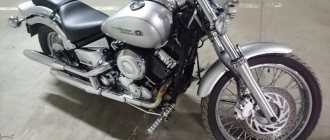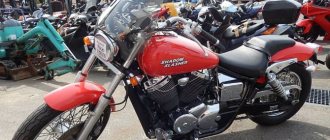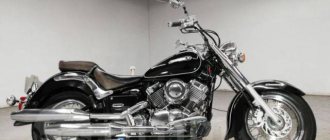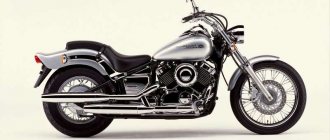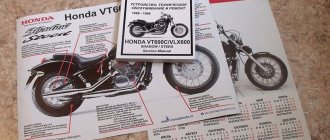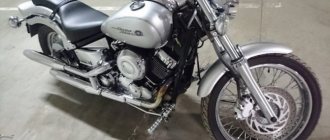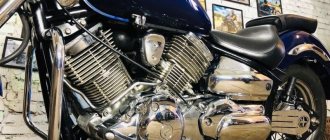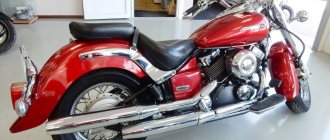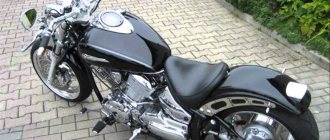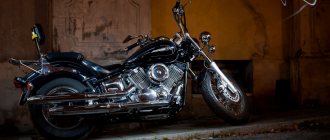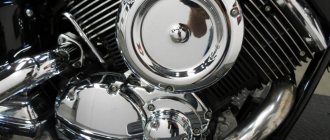- motorcycle model, Yamaha brand,
The Yamaha XVS400 Drag Star cruiser model appeared in 1996 as a successor to the Yamaha Virago 400, differing from it mainly in the new duplex frame (instead of the spinal one) and engine settings, which began to produce less power, but with a shifted torque characteristic to the zone low and medium speeds (operating speeds decreased by 1000 rpm). As a result, the engine began to produce up to 33 hp. power and 32 Nm of torque, with maximum performance starting from 6000 rpm.
The model is built on the basis of the older export version of the Yamaha XVS650 Drag Star / V-Star, differing from it in engine capacity and restyling. In addition, the Yamaha Drag Star 400 was aimed only at the domestic Japanese market.
In 1998, in addition to the regular version of the Drag Star 400, the classic version was introduced - the Yamaha Drag Star 400 Classic. It had a different handlebar, saddle, fenders, headlight, ergonomics and front wheel size. There were no technical differences.
In 2000, the model received a new version of the engine, which in terms of technical characteristics was no different from the previous one, but complied with new environmental standards. The dashboard has also been restyled, receiving an electronic odometer and a fuel level dial indicator.
In 2009, Yamaha introduced an updated version of the Drag Star 400 as a 2010 model, gaining electronic fuel injection and a catalytic converter. Maximum power decreased from 33 to 30 hp, and torque - from 32 to 31 Nm and became available a little later (6250 rpm, instead of 6000 rpm).
2017 was the last year of production of the model. Due to new environmental restrictions, the Yamaha Drag Star 400 can no longer be produced. However, this model is widely represented at Japanese auctions, which makes it available for purchase and export to the Russian Federation. Currently, Drag Star 400 is one of the most popular entry-level cruisers in Russia.
Review of the Yamaha Drag Star 400 motorcycle
In 1996, a motorcycle from Yamaha appeared on the market - Drag Star 400 or XVS 400. As you can guess from the designation, it has an engine with a displacement of 400 cm³. The predecessor of the Drag Star 400 is considered to be the Yamaha Virago 400. And this is not without reason, since the basis for the XVS 400 was a slightly redesigned engine from the Virago 400, although in some respects these are two different motorcycles, but more on that below. The motorcycle was produced only for the Japanese domestic market, which did not prevent it from crossing borders and becoming widespread in the post-Soviet space.
Important information about this manual
Page 5
- Image
- Text
IMPORTANT INFORMATION ABOUT THIS MANUAL
EW000002
PLEASE READ THIS MANUAL CAREFULLY BEFORE OPERATING THIS MOTORCYCLE.
5SC-28197-R0-0.pmd
2003/05/22, 15:04
3
Development of Yamaha Drag Star 400
As noted above, the XVS 400 appeared on the market in 1996 and has remained virtually unchanged. The only exceptions are 1998, 2000 and 2010.
In 1998, the Yamaha Drag Star 400 Classic version appeared. From a technical point of view, it was still the same motorcycle and all the differences were cosmetic. The model received wider fenders, a different seat, steering wheel and optics, in addition, the front wheel was changed. This was done to make it more similar to American classic motorcycles. “Draga” was offered in these two variations, right up to its discontinuation.
In 2000, the motorcycle received an updated engine that complied with new environmental standards without losing any of its performance. In addition to the engine, the dashboard was replaced - an odometer and a fuel level indicator appeared.
In 2009, the designers decided to abandon carburetors, switching the engine power to an injector. The updated motorcycle appeared on the market in 2010. This decision seems more than strange, since the Drag Star 400 was valued by consumers, first of all, for its simplicity and maximum similarity of design with old “iron” motorcycles, but arguing with environmentalists is too expensive. With the switch to injection power, the engine lost its power insignificantly: 30 horsepower versus 33 at 7500 rpm, and the torque also decreased from 32 to 31 Newton per meter. It should be noted that in the carburetor version, 32 Nm was achieved at 6000 rpm, while in the updated version, the maximum torque of 31 Nm is achieved at 6250 rpm. The already considerable mass increased slightly.
It is impossible not to mention that the Yamaha Drag Star 400 has become an excellent platform for tuning, both “garage” and quite professional. This is especially noticeable in those motorcycles that end up outside Japan at auctions. You can often find changes in the design of the steering unit and frame, sometimes for greater similarity with old American models, and with a “dry” frame. In other words, the Japanese, despite the small volume, do not hesitate to turn the “Drag” into choppers and bobbers. There are frequent modifications to the engine to improve its performance. All this sometimes leads to minor confusion in maintenance and repair for new owners.
The last year of production was 2021. The reason for discontinuation of production was the same environmental standards.
Brief history of the model
1996 - official start of sales of the model. Model: Yamaha Drag Star 400 (Japan). Factory designation: 4TR1, 4TR2.
1997 - no significant changes. Model: Yamaha Drag Star 400 (Japan). Factory designation: 4TR3, 4TR4.
1998 - appearance of the Classic modification. Model: Yamaha Drag Star 400; Yamaha Drag Star 400 Classic (Japan). Factory designation: 4TR6; 4TR5, 4TR7.
1999 - no significant changes. Model: Yamaha Drag Star 400; Yamaha Drag Star 400 Classic (Japan). Factory designation: 4TR8; 4TR9.
2000 - restyling of the model. The motorcycle is equipped with a new engine and instrument panel (electronic odometer, fuel level dial indicator). Model: Yamaha Drag Star 400 (Japan). Factory designation: 5KP1, 5KP2.
2001 - no significant changes. Model: Yamaha Drag Star 400; Yamaha Drag Star 400 Classic (Japan). Factory designation: 5KP4, 5KP3.
2002 - no significant changes. Model: Yamaha Drag Star 400; Yamaha Drag Star 400 Classic (Japan). Factory designation: 5KP7, 5KP6.
2003 - no significant changes. Model: Yamaha Drag Star 400; Yamaha Drag Star 400 Classic (Japan). Factory designation: 5KP8, 5KPA.
2004 - no significant changes. Model: Yamaha Drag Star 400; Yamaha Drag Star 400 Classic (Japan). Factory designation: 5KPB, 5KP9.
2005 - no significant changes. Model: Yamaha Drag Star 400; Yamaha Drag Star 400 Classic (Japan). Factory designation: 5KPC, 5KPD.
2006 - no significant changes. Model: Yamaha Drag Star 400; Yamaha Drag Star 400 Classic (Japan). Factory designation: 5KPE; 5KPF, 5KPG.
2007 - no significant changes. Model: Yamaha Drag Star 400; Yamaha Drag Star 400 Classic (Japan). Factory designation: 5KPH, 5KPK; 5KPJ.
2008 - no significant changes. Model: Yamaha Drag Star 400; Yamaha Drag Star 400 Classic (Japan). Factory designation: 5KPL, 5KPM; 5KPN, 5KPP.
2010 - the model receives an injector and a catalyst. Model: Yamaha Drag Star 400; Yamaha Drag Star 400 Classic (Japan). Factory designation: 35C2; 35C1, 35C3.
2012 - no significant changes. Model: Yamaha Drag Star 400; Yamaha Drag Star 400 Classic (Japan). Factory designation: 35C4; 35C5.
2014 - no significant changes. Model: Yamaha Drag Star 400; Yamaha Drag Star 400 Classic (Japan). Factory designation: 35C8; 35C7.
2016 - no significant changes. Model: Yamaha Drag Star 400; Yamaha Drag Star 400 Classic (Japan). Factory designation: 35CA; 35C9.
2017 is the last year of production. Model: Yamaha Drag Star 400; Yamaha Drag Star 400 Classic (Japan). Factory designation: 35CC; 35CB, 35CD.
Technical characteristics of the Yamaha Drag Star 400 (XVS 400) motorcycle
It’s worth starting with the weight and size characteristics. Thanks to the layout of a classic cruiser with a low center of mass, even a loaded version of the motorcycle weighing under 250 kilograms is quite acceptable for weak female hands in a static position. When it comes to maneuvering on the move, if there are any complaints to be made, they tend to apply to the entire cruiser class. Lifting the bike by yourself is easy thanks to its low center of mass.
| Drag Star 400 (1996 – 1999) | Drag Star 400 (2000 – 2009) | Drag Star 400 (2010 – 2017) | Drag Star 400 Classic (1996 – 1999) | Drag Star 400 Classic (2000 – 2009) | Drag Star 400 Classic (2010 – 2017) | |
| Dry weight (kg) | 204 | 209 | 218 | 222 | 224 | 231 |
| Curb weight (kg) | 220 | 225 | 234 | 238 | 240 | 247 |
| Length (mm) | 2340 | 2450 | ||||
| Width (mm) | 845 | 840 | 930 | |||
| Height (mm) | 1045 | 1060 | 1065 | 1105 | 1110 | |
| Seat height (mm) | 660 | 710 | ||||
| Wheelbase (mm) | 1610 | 1625 | ||||
| Front tire size | 100/90-19M/C 57S | 130/90-16M/C 67S | ||||
| Rear tire size | 170/80-15M/C 77S | |||||
| Ground clearance (mm) | 140 | 145 | ||||
| Frame | Steel duplex | |||||
Weight and dimensions characteristics of motorcycles Yamaha Drag Star 400 (XVS 400)
The weight of the “Draga” allows you to feel confident on the road – neither passing oncoming heavy vehicles nor side winds cause any particular discomfort. But, unfortunately, not everything is so perfect. The XVS 400 is equipped with an engine with a displacement of 400 cubic centimeters, and its capabilities are clearly not enough even for overtaking vehicles on certain high-speed sections of the highway. In the city, the dynamics will be at the level of most small cars; high-speed runs from traffic light to traffic light will have to be abandoned. However, the cruiser class itself does not provide for such operation of equipment. In other words, leisurely trips for your own pleasure - that’s what the Drag Star 400 is all about. If we talk about traffic jams, then two features need to be taken into account. The first is an air-cooled engine, so crawling along with everyone else is of course possible, but not recommended. The second is the width of the handlebars, which will not allow you to squeeze into every gap formed, which is perhaps for the best, especially for those who purchase the Drag Star as their first motorcycle.
| Drag Star 400, Drag Star 400 Classic (1996-2009) | Drag Star 400, Drag Star 400 Classic (2010-2017) | |
| Engine | Four-stroke, two-cylinder, V-shaped, air cooled | |
| Working volume | 399 cubic centimeters | |
| Bore diameter/piston stroke | 68/55 millimeters | |
| Compression ratio | 9,7:1 | |
| Gas distribution mechanism | 2 valves per cylinder, single camshaft (SOHC) | |
| Fuel supply | Carburetors 2x Mikuni BDS28 | Injector |
| Ignition | Transistor-coil (TCI) | |
| Engine power | 33 l. With. at 7500 rpm | 30 l. With. at 7500 rpm |
| Torque | 32 Nm at 6000 rpm | 31 Nm at 6250 rpm |
| Acceleration to 100 km/h (according to the manufacturer) | 11.2 seconds | |
| Maximum speed (according to manufacturer) * | 135 km/h | |
| Fuel consumption (according to manufacturer)** | 2.28 liters per 100 km | 2.63 liters per 100 km |
| Fuel tank volume | 15 liters | |
| Transmission | Five-speed | |
| Clutch | Multi-disc in oil bath with cable drive | |
| Wheel drive | Cardan shaft | |
| Front suspension | Telescopic fork with 140 mm travel | |
| Rear suspension | Progressive pendulum with monoshock absorber with preload adjustment with a stroke of 86 millimeters | |
| Front brake | Single disc, 298 mm disc, two-piston caliper | |
| Rear brake | Drum | |
* Quite achievable speed, but it will take a relatively long time to accelerate ** A spherical value in a vacuum, which is not worth looking at at all. The Japanese say that such consumption is achieved at a constant speed of 60 km/h with a passenger, there is no reason not to believe them, but you can and should doubt it.
Separately, you need to pay attention to the wheels. As is not difficult to notice, they are wired, which means there is a camera inside (hello, captain). This decision is due to the same desire to achieve similarity with old motorcycles, and not for additional depreciation. The advantage of this is that an unfortunate cut of asphalt will be transferred with less consequences, but the disadvantage is that repairing a punctured wheel will take a lot of time.
Controversial decisions in the design include the cardan shaft. On the one hand, it deprives the owner of all the delights of caring for the chain. On the other hand, it increases the mass and also has a lower efficiency when transmitting rotational motion to the wheel, which, with an engine with not the highest power, can be attributed to negative aspects.
There is a lot of controversy around the braking capabilities of the Yamaha Drag Star 400. The fact is that the “Drag” 400 has a larger mass than most competitors, and accordingly it is more difficult to stop this mass. In addition, rear wheel braking is carried out using a drum brake, which is usually not serviced in a timely manner. But do not forget that the XVS 400 has very mediocre acceleration dynamics, therefore, in order to start experiencing problems when braking, you must first accelerate the motorcycle. One thing is superimposed on the other and the bottom line is that the brakes installed on the XVS 400 are quite sufficient. In addition, no one bothers you to install “softer” pads.
Known problems and frequent breakdowns of the Yamaha Drag Star 400
Despite the fact that the motorcycle is inferior to other cruisers with 400cc engines in many respects, the XVS 400 can be nominated for the title of “Reliability Standard”. It does not have the problems typical for motorcycles of the XVS family. Due to the simplicity of the design, the motorcycle is difficult to “drive away” even with careless handling. Most breakdowns can be fixed simply by following the instructions and having a minimal set of tools.
The weak point can be considered the wiring, and even then, frequent problems occur due to age and operating conditions, or due to an attempt to turn a motorcycle into a Christmas tree with a sound system, the work of which will be heard in Australia.
The XVS 400 is also unpretentious in maintenance. The owner will spend more time polishing chrome parts than on manipulations related to the technical part. If we talk about consumables and their prices, then you can find absolutely everything and it doesn’t cost the most money. All this ensures “Drag”’s high popularity, which is why it is often recommended to buy it as the first motorcycle.
Pros and cons of Yamaha Drag Star 400
The advantages include:
- its price and maintenance costs;
- unpretentiousness and high reliability;
- “adult” appearance, despite the small cubic capacity;
- low seat height, which makes it possible for even very short people to comfortably operate the motorcycle.
The XVS 400 has few negative points, but they do exist:
- lack of at least some adequate dynamics in gaining speed;
- Weak brakes for a motorcycle of this mass.
Recommendations for purchase
Despite all the positive aspects and general “friendliness” for an inexperienced driver, the Draga 400 can only be recommended for purchase when choosing between it and other 400cc cruisers of the same age. With a 99% probability, you will want something more by the end of the first season, and insufficient dynamics and dimensions not only do not allow you to ride on par with more dynamic equipment, but also will not allow you to fully realize the advantages of riding a motorcycle in the city.
The simplicity and unpretentiousness of the design encourage us to recommend it for purchase. But a lot of alternatives prevent this from happening. A good alternative, in this case, would be the XVS 650, which has all the same advantages, but is more dynamic, which significantly expands the scope of its operation.
Cleaning the Carburetor, adjusting the idle speed
Hello everyone, as they say, if you don’t know what to do in the off-season - CLEAN THE CARS ! This process is fascinating, requiring enormous responsibility and diligence, patience, and quite a few things called WD40 ! and what is also important is THIS MANUAL !!! Yes Yes ! so as not to sit like an old woman in a fairy tale next to a broken trough (well, carba). and so, my friend left before her mother, which means no one will be against cleaning the house))))) I bought 2 liters of gasoline at the gas station and sat comfortably at the table, light and warm, comrades, beauty and that’s all!
It’s good that my friend didn’t see it)))) otherwise I would have gotten stars! I’ll say right away that I analyzed it from the video at the end of the article, I recommend it to everyone! only that dude threw everything in different directions, for those who are going to take it apart for the first time, I advise you to put everything in 2 plates) accordingly, what you took off from the left to the left, what you took off from the right to the right! I’ll say right away if you are the first to disassemble this carb, then pour plenty of WD40 because everything has already stuck! and choose good screwdrivers according to the size, as the bolts are made of plasticine! Everything was sad for me, someone climbed before me, licked all the bolts, I barely tightened them with pliers and replaced them with new ones,
The only thing I didn’t find was one for the 6-edge, but only these, well, okay, you still can’t see the carbs. but if something happens, taking them apart on the road is not a problem!
Everything inside the carb is brass! LOOK CAREFULLY AND WITHOUT FANATISM ! everything breaks down easily! (from the life of a group member: licked the main jet costs 400 rubles on a megazip and 600 rubles for delivery and a 2-week wait)
I didn’t halve the carbs because I couldn’t unscrew them (well, there’s nothing really wrong with that, you can’t clean one small membrane) I washed everything in gasoline. and twisted it back.
After cleaning, check the gasoline level in the chamber!
very simply place the carb on a flat surface: unscrew the bolt ( 1 ) and connect the transparent hose to (2) lead it to the mark (3) and connect the hose to (4) and fill the petrol tube, the floats will work and stop the flow and you will see what They fill the level with gasoline, mine was about 1.5 cm lower, look in the manual which lever to bend to raise the level, and through trial and error achieve the level! I’ll be honest, I never met the level, I stopped at - 0.5 cm from the risk, in principle it’s not fatal! It’s not very easy to catch, I overdid it and the carb overflowed, I didn’t bend it and the carb didn’t top up !!!!
You also have the opportunity to set the quality of the mixture using this needle:
Inside it you will find a plastic bolt, unscrew it and remove the game!
there are 5 divisions on it by default in the middle one! Adjustment is carried out by candles !! unscrew the spark plugs and look at them; if they are the right color, then everything is fine, don’t worry, put it back together! if the candles are according to the picture
then move accordingly 1 division from the middle: if the mixture is lean, then to the left! if you're rich, then to the right!
IN OTHER CASES (for example, to increase the forward moment) IT IS NOT WORTH MOVING!!!
further in the manual it says to set the idle mixture quality screws
(hereinafter referred to as XX) for 2 turns: I’ll decipher it right away - 1 turn is 360 degrees ! I didn’t understand correctly at first, and took it for 180 degrees, and I haven’t been able to set it up correctly for a long time! and again there was an innovation for me, a friend said that in the English manual you need to unscrew it 2.5 turns !!! no sooner said than done! Well, that’s basically it, I went to install it!
IF YOU DO NOT HAVE A ZERO PUT A FILTER!!!! and then start the engine, since you will have too easy air access without the filter you set, and when you put on the filter everything will go wrong! I HAVE NULEVIK so in the first video I can launch and configure without it.
